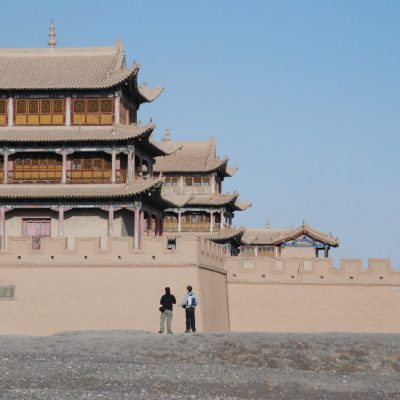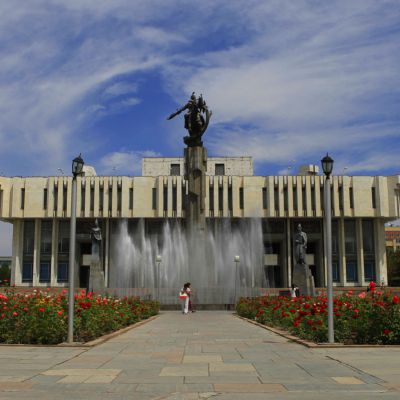Kyrgyzstan
Kyrgyzstan is a country, which is comfortably located between the Uzbek deserts, Kazakh steppes, Tajikistan and Western China. The territory of Kyrgyzstan is famous with the Tien Shan and the Pamirs mountain systems. Everyone who is choosing his tour to Kyrgyzstan tries to include in the program such well-known highest world peaks as Peak Pobeda (7439 m.), Lenin Peak (7134 m.) and Khan Tengri Peak (7010 m.). These grand mountains have turned Kyrgyzstan into the land of the glaciers, noisy mountain rivers and brisk streams, huge snow fields with Alpine meadows and magnificent fertile valleys.
The capital of Kyrgyzstan is Bishkek city, which is not only an administrative, but cultural and educational center as well. The population of Bishkek is about 1 million people; while the population of the whole Kyrgyzstan is little bit over 6 million people.
If someone asks what does mark Kyrgyzstan out other destinations, we would mention 3 things:
- Kyrgyzstan on the Great Silk Road
The Great Silk Road left some monuments and ruins of settlements that are interesting for tourists.
In 2015 4 monuments in Kyrgyzstan were acknowledged as UNESCO heritage. So now there is possibility to see and visit those Silk Road places that are noted in history books. High altitude passes and lakes, deep canyons with traditional nomadic houses named yurts, historical objects belongs to the legacy of the Silk Road and many more breathtaking things can give an unforgettable experience of all tours in Kyrgyzstan.
Usually people choose the tours that include route in several neighboring countries – Uzbekistan, Kazakhstan, Tajikistan, China etc.
- Nomadic culture and the real nomads
There are only 2 countries in world that still have the real nomads – the nomads who follow the original nomadic way of life. These are Mongolia and Kyrgyzstan. Coming to Kyrgyzstan people have the chance to see what the nomadic way of life is about. They can get acquainted with the local nomads at summer pastures and even feel the nomads themselves by spending a night in a real yurt.
- Mountain systems of the Tian Shan and Pamir and active sports
The third reason is our beautiful mountains. Kyrgyzstan is mountainous country – 93% of the country is mountains. There are plenty of trekking and hiking routes both for beginners and professionals. Active vacation is getting more and more popular. People don’t want just beach vacation. Thus for those who choose Kyrgyzstan tours we can offer great combination of active tours and cultural programs.
Yes, travel in Kyrgyzstan is ideal for those tourists who undertake a journey, first of all, to gain new knowledge of the history and culture of the nations and to get impressions from meeting new people.
We hope that you will choose Kyrgyzstan as your next destination and we will make sure to show you its all the beauty and diversity of this beautiful country.
Geography of Kyrgyzstan
Kyrgyzstan is one of the most mountainous countries in the world – about 92% of its territory lies at altitudes above 1000 m above sea level, and the average height is 2750 m. The country is like a “fork” of the two largest mountain systems, reaching its maximum height (Pobeda Peak, 7439 m) in the vast Tien-Shan mountain site in the eastern part of the country, bordering China and Kazakhstan.
Through the entire northern part of the country, in the latitudinal direction, stretches nearly 600 km chain of mountain ranges of Ala-Toos or Alataus that in Kyrgyz mean “colorful mountains” – Terskey-Ala-Too (4808 m), Kyungey-Ala-Too (4770 m), the Kirghiz ridge (Kyrgyz Alatau , 4855 m), Talas Alatau (4,251 m), Suusamyr-Too (3828 m), Karakolsky ridge (4273 m) and others. They form the northern mountainous frontier of the country, dividing the territory of Kyrgyzstan from the arid deserts and Moyynkum Saryesik-Atyrau. The southern part of the country form a powerful ridges Chon-Alai (Trance-Alay) mountain system, which is the second highest peak in Kyrgyzstan – Lenin Peak (7134 m), and the border with China back Kakshaal-Too.
The central part of Kyrgyzstan formed ridges and spurs of the grand mountains of Tien Shan (“Celestial Mountains”) – Jeti (4896 m), Moldo-Too (4099 m), At-Bashy (4786 m), Borkoldoy, Chatkal (4503 m) and Alai (5259 m) mountain ranges, stretching from west to east over 2400 km (continuing on the territory of China , Tajikistan and Uzbekistan ). Moreover, from the main axis of the Tien Shan to the north and south moves a lot of high ridges (Suusamyr-Too – 3828 m, Ferghana – 4692 m, etc.) and arrays (Ak-Shiyrak, etc.), forming a powerful mountain sites. Between the ridges are large tectonic depressions Susamyr, Srednenarynskoy, Turfan, Hamiyskoy, Ili, Chu, Toktogul and Talas basins, and Lake Issyk-Kul, Chater-Kul, Son-Kul, etc.
In the eastern part of Central Tien-Shan Mountains, within the vast mountain site, clearly expressed in two converging bands of mountain ridges, separated by a sequence of valleys and basins, elongated in the latitudinal direction. In the composition range Kakshaal-Too rises the highest point in the whole range – Peak Pobeda (7439 m). And nearby, in the ridge Tengri-Tag, is another seventhousander – Mount Khan-Tengri (Lord of Heaven “, 7010 m), considered a symbol and a business card of the Tien Shan. The lowest point of the country lies on the banks of the river Kara (Kara-Darya 132 m), thus differences in elevation in the territory of Kyrgyzstan reaches 7300 m.
Mountain areas are covered with a powerful glaciation – there are about 8000 glaciers with a total area of more than 8100 km (4% of the territory), ranging from the dizzying heights up to 2900 m above sea level. The largest glacier of our country is Inylchek (Enilchek, North and South), which together with the adjacent ice fields reach an area of 800 square km. For the highlands is characterized by glacial landforms (cirques, ditches, troughs, etc.), the slopes of ravines are covered with numerous dunes, and the bed of the valleys – thick moraine deposits of the glaciers. Wide-spread high-altitude permafrost, which covers the slopes and the bed almost 60% of the high mountain valleys. Also, frequent small alpine lakes and even swampy areas. From the mountains runs more than 12000 rivers and streams that feed as many lakes and rivers of Naryn, Talas , Ili, Chu, and Aksu.
A characteristic feature of the local landscape is the alternation of high mountains and deep intermontane basins, forming a labyrinth. The vegetation in the piedmont plains are mostly desert and semi-desert, in the mountains – mountain steppes and forests, alpine meadows and meadow-steppe. Moreover, in the territory of Kyrgyzstan practically all natural zones of northern hemisphere of the planet – can be found here and thick mountain forests and arid steppes, deserts, including alpine and tundra, floodplain meadows and mountain valley swamps, all of which are often removed from each other at a distance of no more than a couple-three hundred meters. Flora of the country’s population of about 4200 species of higher plants, and fauna – some 500 species of vertebrates, of which 86 – mammals, more than 50 species of fish and about 360 birds. For agriculture, suitable only 7 % of the republic.
Kyrgyzstan Terrain
Kyrgyzstan is the mountainous country. Most of Kyrgyzstan is a mountainous system of the Tien Shan, and only the extreme south-west is in the Pamir-Alayu. High point – Victory Peak, or Dzhengish-Chokusu (7439 m), located in the Tien Shan in the east, on the border with China.
Many of the ranges of the Tien Shan – Talas Alatau, Kyrgyz Ala-Too, Kyungey Ala-Too, Terskey-Ala-Too and others – are predominantly sub latitudinal. Big Fergana mountain range is oriented from northwest to southeast, and the ridge Kakshal-Too – with the south-west to north-east (along the border with China), with a single pass in the Tien Shan Torugart (3752 m). Between the ridges Kyung-Ala-Too and Terskey-Ala-Too is intermontane basin, the bottom of employing a large lake Issyk-Kul, the so-called “Kyrgyz Sea”. To the north of the Kyrgyz Range located submontane Chu depression, mastered and most densely populated part of the republic. Extensive Fergana valley enters the limits of Kyrgyzstan , only the peripheral parts. In the Kyrgyz part of the Pamir-Alai dominated sublatitudinal relief elements – Alai Range, the Alai Valley, Turkestan and Trans-Alay (highest point – Lenin Peak, 7134 m) ranges. In the eastern part of the Trans-Alay Range Pamir highway intersects with the Kyzyl-Art Pass. In the upper tier of the mountain glaciers developed. The snow line is located at altitudes of ca. 3 km to the peripheral ridges and 4,0 – 4,5 km is on the internal ridges. The largest of them are dendritovye (Inylchek length of 59,5 km and North Inylchek – 38,2 km), with a few ice-flows. In addition, widespread valley, cirques and hanging glaciers, as well as characteristic of the Tien Shan glaciers are flat tops. Tien Shan is rich in water resources and is a major supplier of water for the surrounding arid plains.
Climate and Water of Kyrgyzstan
Climate
Kyrgyzstan has a continental climate. The western and northern slopes of the mountains receive more precipitation. Precipitation increases with altitude up to 5000 m. At higher altitudes precipitation falls as snow, and even in summer frosts are possible. Average annual precipitation on the northern slopes of ca. 750 mm in the south-western slopes of the Fergana Range – 950 mm, and the north-east – 230 mm.
Average January temperatures range from -2 ° to -8 °C in the valleys and from -8 ° to -20 ° C in medium-altitude mountains. In high average January temperature – approx. -28 ° C. In many parts of Kyrgyzstan, except the high mountains in winter are often thaw. Summer is hot and dry, with average July temperature in the valleys of 20-27 ° C In the mid 15-17 ° C, while in the high 5 ° C and below.
Water
Within the limits of Kyrgyzstan there are more than 3000 lakes, including the picturesque lake Issyk-Kul – one of the deepest in the world (maximum depth 668 m). Large rivers – Chu, Naryn and Talas – originate in the highlands. Chu occurs in the north, and flows 145 km on the border territory between Kyrgyzstan and Kazakhstan. The Naryn River, merging with the district. Kara Darya, forming the Syr Darya, which flows eastward into the Fergana Valley. Talas drains the north-eastern Kyrgyzstan.
Plant and animal life in Kyrgyzstan
Flora of Kyrgyzstan’s very diverse, not less than 1 / 4 of all species are endemic. For the Tien Shan is characterized by a forest belt of the Tien Shan spruce, which replaced the above thickets of juniper and subalpine meadows. In the northern mountains framing the Fergana valley in places preserved forest nut (walnut). In high prevalent sub-alpine and alpine meadows used for many years under the summer pastures for sheep. At the highest levels of the relief is widely developed subnival zone with rubble heaps and snowfields. Herbaceous plants there have been very few, are common mosses and lichens.
In the foothills of distributed ephemeral desert, semi-deserts and dry steppes above shifting shrubs and woodlands.
In the highlands inhabited by ibex “teke”, mountain sheep “argali”, snow leopard, stone marten, red wolf, gray and red mountain marmots. In the forest mountain belt distributed deer, wolf, weasel, wild boar, lynx, brown bear, fox, marten. For steppe highland areas and the adjacent plains are characterized numerous species of rodents, including yellow, gopher, great coney, red-tailed gerbils, various reptiles, from ungulates – gazelle, birds – partridge, bustard, etc.
History of Kyrgyzstan
The area of present-day Kyrgyzstan contains evidence of human habitation from the time of the Lower Paleolithic on, approximately 300,000 years ago. Archeologists suggest that two types of economies developed in the territory—farming and pastoral nomadism. By the 7th century BC nomadism had become predominant, and the area was controlled by various tribal alliances. In the north the Saki (7th–3rd centuries BC) were succeeded by the Usuni (2nd century BC –5th century AD); in the south the Parkan state (2nd–1st centuries BC) was replaced by the Kushani kingdom (1st–4th century AD). The ethnic identity of those peoples is the subject of much debate, but they were not Turkic. From the 6th century on, various Turkic tribes began to push westward, eventually settling most of Central Asia, including Kyrgyzstan. Much of present Kyrgyzstan was united by the 7th century as part of the West Turkic Kaganate, and replaced in the 8th century by the Turgash, who in turn were conquered by the Karluk, who originated in the Altai region further north.
When the present-day Kyrgyz first came to this territory is the subject of much debate. References to tribes of that name living in the Altai occur in the 10th century, but another people with the same name who lived along the Enisei River are first mentioned in records from the 2nd century BC. The Enisei Kyrgyz formed the Kyrgyz Kaganate in about AD 650, which survived until defeat by Genghiz Khan in 1209. Kyrgyz tradition prefers to see its origin in that state, but ethnographers and archeologists view the claim with considerable skepticism.
Evidence suggests instead that the present-day Kyrgyz are an amalgamation of various peoples, as existing tribes incorporated themselves into fresh waves of conquerors. The territory was part of the Karakhanid state from about 950–1150, during which the urban population was actively involved in trade and manufacturing along the Silk Road. Conversion to Islam also began in this period.
Genghiz Khan conquered the area in the 13th century, destroying most of the Karakhanid culture and introducing large numbers of new peoples into the area, of Turkic, Mongol, and Tibetan stock. The resulting mix of tribes was almost certainly the basis for the present-day Kyrgyz people, who retain much of the memory of those origins in the orally preserved genealogies of their 40 clans and tribes. The present Kyrgyzstan flag includes the depiction of a sun with one ray for each tribe. The Kyrgyz follow Mongol practice of dividing their people into left (sol ) and right (ong) “wings,” said to reflect either the deployment of troops in military formation, or the tribe’s original place of habitation. There is also a third group, the ichkilik, that seems to include parts of the Kyrgyz identity.
From the 15th century until the 17th century the Kyrgyz tribes were part of the larger delineation of Central Asian history, which distinguished agricultural sedents from pastoral nomads. The appearance of the same tribal names among Kazakhs, Kyrgyz, and Uzbeks suggests how the people of this territory formed a series of tribal alliances, rather than a true state.
In the 18th century the Kyrgyz began to come under pressure from Mongol tribes farther east. This prompted some of the northern tribes to send delegations to the Russians, who had pushed into Siberia in the 17th century, and who were beginning to take what is now northern Kazakhstan under its control. The Russians made no distinction between the Kazakhs and Kyrgyz, calling both Kyrgyz. The southern Kyrgyz, however, were conquered by the Kokand Khanate, established in the late 18th century, separating them from the northern Kyrgyz. This split between south and north continues to the present day in Kyrgyz life.
Russian expansion into what it called the Steppe included Kyrgyzstan. Most of northern Kyrgyzstan was incorporated into the empire by 1863; the south followed in 1876, when Russia destroyed the Kokand Khanate. Administratively, present-day Kyrgyzstan was split among four guberniyas. Beginning in the 1890s Russia settled Russian and other European farmers into the fertile river valleys of the north, forcing Kyrgyz nomads higher into the mountains.
By 1916, Russia’s policies of livestock requisition and land use had left the Kyrgyz badly impoverished. When Russia attempted to issue a draft call-up for Central Asian males, including the Kyrgyz, widespread fighting broke out all across the territory. The uprisings were suppressed, with great loss of life; population in the northern part dropped as much as 40%. Since independence in 1991, the state has commemorated the 1916 uprising as genocide.
Hostility to the tsars meant that there was some support for the Bolsheviks, at least until it became clear that Lenin was not going to encourage the development of national states. Resistance to the Russians continued sporadically until the mid-1920s, in what Russian historians have labeled the Basmachi Rebellion.
As Bolshevik power was consolidated, Kyrgyzstan was first made an autonomous oblast (political unit) of the Russian Federation in 1924; it was upgraded in 1926 to an autonomous republic, but still within Russia. (At that time Russia was one of the Soviet Republics.) Kyrgyzstan did not become a full Soviet Republic until 1936.
The republic was regarded as one of the least developed of the Soviet states, politically and economically. Thus, it came as a great surprise when, on 28 October 1990, Kyrgyzstan became the first Soviet republic to select its own leader. The Kyrgyzstan legislature refused to ratify Communist Party leader Absamat Masaliyev’s bid to become the republic’s president, and elected instead Askar Akayev, president of the republic’s Academy of Science. Akayev and his supporters began asserting Kyrgyz nationalism and wresting political and economic control over the republic from the Soviet Communist Party. These efforts were briefly interrupted by an attempted coup in Moscow by Communist Party hard-liners in August 1991. Akayev bravely condemned the coup and, after it fizzled, on 30 August 1991 he severed ties with the Communist Party and Kyrgyzstan declared its independence. On 12 October 1991, Akayev’s presidency was confirmed by direct popular election.
Languages
Kyrgyzstan is the only former Soviet Central Asian republic to start out with two official languages, in this case Russian and Kyrgyz. An aggressive post-Soviet campaign was established to make the latter the official national language in all commercial and government uses by 1997; Russian is still used extensively, and the non-Kyrgyz population, most of them are not Kyrgyz speakers, but hostile to forcible Kyrgyzification.
Kyrgyzstan has a high literacy rate (99%), and a strong tradition of educating all citizens. However, its ambitious program to restructure the Soviet educational system is hampered by low funding and loss of teachers. School attendance is mandatory through grade nine. Kyrgyz is increasingly used for instruction; the transition from Russian to Kyrgyz has been hampered by lack of textbooks. It remains to be seen, whether Russian will continue as the second language of choice, or whether English will supersede it as a lingua franca.
Literary works
Manas is a traditional epic poem of the Kyrgyz people and the name of the epic’s eponymous hero. The poem, with close to half a million lines, is twenty times longer than Homer’s Odyssey and the longest epic in the world. It is a patriotic work recounting the exploits of Manas and his descendants and followers, who fought against the Chinese and Kalmyks in the ninth century to preserve Kyrgyz independence.
Kyrgyz Traditional Music & Instruments
Aside from the komuz, Kyrgyz folk instruments include the kyl kiak (qyl-qyiyak), a two-stringed upright bow instrument (cf. fiddle), sybyzgy, a side-blown flute, chopo-choor and the temir ooz komuz (mouth komuz), also known as jew’s harp in some countries. The komuz is the national instrument of Kyrgyzstan. It is a plucked string instrument. The kyl kiak, however, is also an important symbol of Kyrgyz identity. It is a string instrument, related to the Mongolian morin-huur, and is associated with horses and the vital role they play in Kyrgyz culture.
Kyrgyz textile work
Kyrgyz women produce a wide range of textiles, mostly from the felt of their sheep. Ancient patterns are nowadays adapted to the tourist and export market, but it is still a living tradition, in that all yurts and most houses contain hand-made carpets or rugs called Shyrdak.
Tush kyiz are large, elaborately embroidered wall hangings, traditionally made in Kyrgyzstan and Kazakhstan by elder women to commemorate the marriage of a son or daughter.
Colors and designs are chosen to symbolize Kyrgyz traditions and rural life. Flowers, plants, animals, stylized horns, national designs and emblems of Kyrgyz life are often found in these ornate and colorful embroideries. Designs are sometimes dated and signed by the artist upon completion of the work, which may take years to finish. The tush kyiz is hung in the yurt over the marriage bed of the couple, and symbolize their pride in their Kyrgyz traditions.
Flat cushions called “Tushyok”, which are usually made in shadow-pairs. These are seen on every chair, padding the seat.
Kyrgyzstan Traditional Cuisine
Traditional Kyrgyz food revolves around mutton and horse meat, as well as various milk products. The cooking techniques and major ingredients have been strongly influenced by the nation’s nomadic way of life. For example, most cooking techniques are mostly aimed at long-term preservation of food. Mutton is the favorite meat, although it is not always affordable.
Kyrgyzstan is a home to many different nationalities and their various cuisines. In larger cities, such as Bishkek, Osh, Jalal-Abad, and Karakol, you can find many options at any price range. On the road and in the villages, the cuisine tends to be standard Kyrgyz dishes, liberally flavored with oil or sheep fat, which are considered both delicious and extremely healthy by the local population.
Hunting with birds in Kyrgyzstan
Hunting with eagles is also ancient Kyrgyz tradition; the hunters with eagles are called berkutchy by Kyrgyz people.
Berkutchy is a life’s profession, and in Kyrgyzstan is often a hereditary one. The relationship of the bird and its master is constant, and all-consuming. In the training of a young eagle, the berkutchy must sacrifice his sleep for a long period. For weeks, the growing bird is rendered sightless under its hood until its dependence on its master become complete. Such intimacy must turn into a lifelong trust with the eagle – twenty years or more. It is said that as the man trains the eagle, so does the eagle trains his man. There is a proverb in Kyrgyz: “There are three things a real man should have: a fast horse, a hound, and a golden eagle”.
Kyrgyz Horse Games Festival
From the ancient time horses played a big role for people in Kyrgyzstan. In the 3rd century people were even buried with their horses. Children were given the name of horses, because it was believed that evil spirits were afraid of horses.
There are many horse games in Kyrgyzstan. The most widespread games are:
Ulak Tartish. The origin of this game developed in antiquity when herds of cattle grazed in the steppes and mountains all year round, exposed to possible attacks by wolves or other big-sized predators.
Nomads did not have firearms and that is why shepherds could not deal with wolves. In this way they were beating a wolf with sticks until somebody managed to catch it and to through up. The wolf would break his bones and would not be able to move anymore.
People wanted to be ready for such cases and they began to have wrestling on horseback for a goat’s carcass. The weigh of a goat on an average is 30 – 40 kilograms. The game is played on a field that is 300 meters long and 150 meters wide. The goal of the game is to seize the goat’s carcass and deliver it into the gates of the contesting team.
Aht Chabysh is Long-Distant Race. Usually this game took place in connection with some holiday or festival. The distance was 100 kilometers. Very often the riders were young boys of 10-13 years age, sometimes riding without a saddle.
Oodarysh – Wrestling on Horseback. Wrestling on horseback is also a popular activity. There are two riders, who try to pull each other off their horses. It is allowed to throw the rival together with his horse to the ground.
Kyz-Kumai – Chase the bride. In older times, this game was a part of the wedding. The bride had the best horse and she had to ride away from her groom. The husband-to-be had to chase her and prove his love by giving all in order to catch her. The game stopped when he caught and kissed her. As mentioned above, the groom got the worse horse, why he would sometimes fail to catch his fiancée. In this case, he would ride away and his fiancée would follow him to beat with her Kamchi (horse-whip). But the wedding would be held anyway.
Besides the above-mentioned, there are also games where a rider shows his skills by picking up a coin from the ground or shooting at a target while galloping, as well as many others interesting tasks.
Cultural events
Kyrgyzstan festivals are a reflection of the rich history of nomadic customs and traditions of the Kyrgyz people. During the holidays, men traditionally demonstrate their equestrian and racing skills, hunters compete in archery and falconry hunting, and women present their handicrafts.
Today, as hundreds year ago, the Kyrgyz still organize big festivals, uniting people not only from Kyrgyzstan, but also from different countries. The most popular of these are Orozo Ait, At Chabysh festival, National horse games, Nooruz, Taigan and Burkut Festival. Festivals are held on picturesque jailoo (pasture), with installation of Yurt (tents), preparation of national dishes, arranging exhibitions and sales of folk crafts items. items.
The National Festivals of Kyrgyzstan is the best way to enjoy the atmosphere of the Kyrgyz centuries-old traditions.
Orozo Ait
This feast, known as Eid al-Fitr in Arabic, at the end of Ramadan is celebrated with a large meal shared by family and friends. Gifts of new clothes and alms to the poor are traditionally given at this time.
At Chabysh festival
A horse-centred outdoor festival that involves long-distance horse races, traditional horse games, poetry competitions, music concerts and handicraft exhibitions.
National horse games
Horses are a large part of Kyrgyz culture and that is why every year National horse games are held. These include Ulak tartysh, where two teams of riders fight it out over a goat carcass and kyz-kumay, where the male rider has to catch up to horsewoman in order to receive his prize, a kiss.
Nooruz
Date: 21 March
Also, known as Navrus, this event, which dates back to Zoroastrian times, is the most important of the traditional holidays that takes place in Kyrgyzstan. At Nooruz, a special meal is prepared, friends are visited, debts are repaid and the whole country celebrates with music, dancing and traditional games.
We do not manage the events described on this page. Although, we always ready to provide the most relevant and accurate information under you request.
Bishkek – the capital of Kyrgyzstan
Nice green city with a number of parks, soviet time monuments and combination of old houses, and soviet buildings. Many of exciting sights located outside Bishkek, including ruins of ancient cities and beautiful valleys of Kyrgyz Ala-Too.
The capital, Bishkek city, is situated in the Chui valley in the north of the country. It was founded in 1878 and originally was called Pishpek, which is the name of the wooden paddle with which the Kyrgyz make their kymyz (kymyz – fermented mare’s milk), the national drink. Later, during the Soviet Union period, it was named Frunze after the famous Russian General Mikhail Frunze. At the time of Independence in 1991, it was renamed Bishkek.
The city has been influenced by the Russians from the beginning, and actually more or less built by them. Most of the buildings you see today are built in a typically Soviet architectural style, and the trees in the parks, boulevards and alleys are watered by a system of canals built by Russians. Those boulevards and parks make this a pleasant city to live in, as they provide total shade in summer, when temperatures may reach 40 degrees Celsius (105 F), and the open canal system also helps to keep the summer bearable. Bishkek is known to be one of the greenest cities in Central Asia as a result of this planning.
Bishkek cannot claim to be one of the major cities of the world, like London, Paris or New York. It is, however, the capital city of Kyrgyzstan and does have a number of important and interesting buildings, monuments, parks, museums, galleries, theatres and other places worth seeing or visiting.
- Ala-Too Square is the central square in Bishkek, Kyrgyzstan. The square was built in 1984 to celebrate the 60th anniversary of the Kyrgyz SSR, at which time a massive statue of Lenin was placed in the square’s center. The statue of Lenin was moved in 2003 to a smaller square in the city, and a new statue called Erkindik (Freedom) was installed in its place.
- Osh Bazaar is a true oriental bazaar that you will not see anywhere else, because it reflects the true nature and coloring of the nation. Entering this market, you find yourself in the past, here, as many years ago, it would seem, nothing has changed, crowded market, envelops buyers with the cloud of spicy aromas. Dozens of unique spices and seasonings: basil, dill, parsley, coriander, celery, onion, garlic, thyme, cumin, red and black pepper, dried tomatoes, barberry, black, zira, bunium, sesame. About six dozen species and varieties of spices and seasonings can be counted on the shelves. Vendors vying offer raisins and dried apricots, almonds and pistachios, walnuts and peanuts.
- Victory Square. The 9th of May, 1945 is the Victory of Soviet Union over Fascist Germany in the Great Patriotic War started on 22nd of June, 1941. The Memorial was constructed in 1985, to commemorate the 40th anniversary of the Victory. Three curved arcs represent a yurt. There is a statue of Kyrgyz woman inside the construction. She (mother, wife) is standing under a tunduk in the form of a funeral wreath at the eternal flame, waiting for her son / husband, who never returned home from the front. According to the tradition the memorial is must-to-visit place for all the wedding ceremonies.
Ala Archa National Park
Ala Archa National Park is an alpine national park in the Tian Shan Mountains of Kyrgyzstan, established in 1979 and located approximately 40 km south of the capital city of Bishkek. The park, which includes the gorge of the Ala-Archa River and the mountains surrounding it, is a popular destination point for weekend hikers, horse trekkers, skiers as well as mountain climbers looking for challenging ice, rock and mixed routes. The park is open year round, although the most popular season is late summer and early fall.
In Kyrgyz, the Archa, which gives the park its name, is a juniper, which Kyrgyz people have traditionally held in special esteem, using smoke from its burning brenches to chase away evil spirits. However, the archa is not supposed to be planted near the home, because it is believed gradually to sap the energy from human beings living close-by.
The park covers about 200 square kilometers, and its altitude ranges from about 1,500 meters at the entrance to a maximum of 4,895 meters at Peak Semenov Tian-Shanski, the highest peak in the Kyrgyz Ala Too range of the Tian Shan. There are more than 20 small and large glaciers and some 50 mountain peaks within the park. Two small rivers, Adygene and Ak-Sai originate from these glaciers’ melting waters. Adygene gorge is a beautifully wooded valley, with waterfalls, springs and abundant trout. A small reservoir on the Kargay-Bulak river was built to study the Amu Darya trout. Other wildlife includes the very rare snow leopard (in Kyrgyz: “Ilbirs”) on the alpine meadows and snowfields above 2,500 m elevation, wild goats, roe deer and marmots.
Burana Tower
Burana Tower is a large minaret in the Chuy valley in northern Kyrgyzstan. It is located about 80 km east of the country’s capital Bishkek, near the town of Tokmok. The tower, along with grave markers, some earthworks and the remnants of a castle and three mausoleums, is all that remains of the ancient city of Balasagun which was established by Karakhanids at the end of the 10th century. An external staircase and steep, winding stairway inside the tower enables visitors to climb to the top.
The tower was originally 45 m (148 ft) high. However, number of earthquakes caused significant damage to the structure. The last major earthquake in the 15th century destroyed the top half of the tower, reducing it to its current height of 24 m (82 ft). A renovation project was carried out in the 1970s to restore its foundation and repair the west-facing side of the tower, which was in danger of collapse.
The entire site, including the mausoleums, castle foundations and grave markers, now functions as museum and there is a small building on the site containing historical information as well as artifacts found at the site and in the surrounding region.
Legend
A legend connected with the tower says that a witch warned a local king that his newly-born daughter would die once she reached the age of eighteen. To protect her, he built a tall tower where he sequestered his daughter. No one entered the tower, except the daughter’s servant who brought her food. The daughter grew up alone and became a beautiful young lady. One day, however, a poisonous spider was hiding in the food brought by the servant. The spider bit the girl, and she died in the tower, at the age of eighteen.
Cholpon-Ata Petroglyphs, Kyrgyzstan
Cholpon Ata Petroglyphs is a unique ancient monuments, which are located on territory of Cholpon-Ata town. There are Bronze Age settlement and ancient sacred place under open sky with stone painting. Andronic tribes or Arian tribes (in the middle of II millennium – VIII century B.C.) gave us the artists who began creating these peculiar art galleries, which consist of thousand petroglyphs. The Saka tribes (VIII-III centuries B.C.) made their contribution for further development of the rock painting. Saka’s artists created rock drawings in so called Saka-Scythian animal style of art, which attracts attention with their mastership and realistic images. The latest petroglyphs were dated by Turkic period (VI-IX centuries).
Cholpon Ata Open Air museum is the most accessible and visitable part of North Issyk-Kul accumulation of the petroglyphs. That site was gigantic temple under open sky, which occupied western part of modern Cholpon-Ata town, and where ancient people worshipped to celestial bodies and did sacraments and mysteries. The rock paintings took an important sacramental role in realizing rituals.
They were some kind of virtual sacrifice and prayer, printed on the stone. Alongside with the petroglyphs, there are stone circles, perhaps an ancient kin sacred site with an interesting natural phenomenon – geomagnetic propitious fields. There are some grounds for suppositions, that big stone circles (some tens meters in diameter) used as astronomy observatories.
Cholpon Ata petroglyphs are unique in many aspects. First, because of artistic realism of the images, many rock drawings belong to masterpieces of Saka-Scythian animal style art. Secondly, the sizes of some petroglyphs are more than one meter which is really rare. At third, many scenes and subjects are original, typical only for North Issyk-Kul petroglyphs. At forth, a technique of making some paintings, for example a relief image of deer, fulfilled with the usage as natural prominences of the stone.
The central petroglyph in low part of the museum is an embodiment of all unique features. There is a flock of rock goats (teke or ibex). The figures of ibexes, perhaps the biggest in Central Asia presented with unusual expression that allows attributing this petroglyph to outstanding masterpiece Saka-Scythian animal style of art. The figures of hunters and tame-breeding bars (snow leopards) during penned hunt are one the background of the rock painting. This kind of driving off hunt existed in Ancient Egypt, where hunters used cheetah in hunting of antelope. By the way, there is a petroglyph with images of hunting dynamically leopards in the museum. This petroglyph has no analogies in Central Asia.
Karakol town
This peaceful Russian town was founded on 1st of July in 1869 as Russian Military fortification on the Shore of Issyk-Kul Lake. By this time the town had a high proportion of military officers, explorers of Russian Geographical society, merchants and professionals. The town’s Soviet name was Prjevalsk after the Great Russian Explorer of Central Asia and China Nikolai Prjevalski whose last expedition ended here and who is buried on the lake shore near Karakol.
Sights to see here include:
Holy Trinity Cathedral
Present wooden building was built in 1895 and partly destroyed by Bolsheviks in 1930. Services are again being held, since the reconstruction in 1991. This Russian Orthodox Church contains unique icon of Tikhvinian Virgin Mary that is believed to cure people from almost any disease.
Dungan Mosque
This is one of the most beautiful Karakol’s piece of architecture. It was built by dungans, without any nails in 1911. Despite the fact that it was built by Dungans it serves all muslims of Karakol despite their ethnic background. The building impresses with an amount of perfect wood carving. You can find some items of Chinese mythology in the patterns.
Sunday Animal market
A must visit place is a Sunday animal market. You will see lots of people selling and buying horses, cows, sheep and other domestic animals.
Museum of Przhevalski
State Memorial Museum of the Great Russian traveller Nikolai Mikhailovich Przhevalsky located 13 km from Karakol, on the shore of Issyk-Kul Lake. It includes beautiful monument, traveler’s grave, chapel and indoor museum that contains a number of documents, deeds and diplomas of Przhevalsky, the collection of stuffed birds and animals and personal belongings of the scientist.
Tash Rabat
Tash-Rabat is a carefully restored stone building that once housed an inn on the Great Silk Road. Its date of origin is a complete mystery; however, there is an archaeological evidence to suggest that the site was occupied in the 10th century. There is evidence that it was a place of both rest and worship and would have served to protect caravans traveling to and from China from both the ravages of the weather and of bandits; even before the time of Genghis Khan and Tamerlane.
Son Kul Lake
Song Köl (also Son Kul, Songköl, Song-Köl) is an alpine lake in northern Naryn Province, Kyrgyzstan. It is the second largest lake in Kyrgyzstan (18x29km wide, 13 meters deep) after Issyk Kul Lake. Its name, meaning «following lake», is popularly considered to refer to this relation. It is surrounded by a broad summer pasture and then mountains. Its beauty is greatly praised, but it is rather inaccessible. The best approach seems to be the 85 km road from Sary-Bulak on the main north-south highway. Other routes require 4x4s. There are no facilities on the lake, but local herders will provide supplies and lend yurts. The area is inhabited and safely accessible only from June to September.
Osh city
Osh is the Kyrgyzstan’s second biggest city located in the south, near the border with Uzbekistan. The city’s population is about 250.000 people with dominantly Uzbek people. They say Osh is older than Rome, and the number of legends tells about Alexander the Great who had passed Osh on his way to India, King Solomon who had slept on the place of present Solomon throne and Bobur the Lion, the person who conquered India. Places to see include one of the best Central Asia’s open markets, overcrowded with Kyrgyz, Uzbek and Tadjik people offering everything from seasonal fruits and vegetables to traditional hats, knives, horseshoes etc. The line of craftsmen still uses ancient technologies for making everyday tools: knives, horseshoes and steel decorations for the houses.
Solomon’s throne – the mountain of King Solomon called Suleiman Mountain. According to the legend this mount appeared after King Solomon took rest on this place. For Central Asia Muslims Taht-I-Suleiman is the third sacred place after Mecca and Medina. On the top of the mount there is an ancient mosque which was built by Bobur in 1510 and has survived till the present time. There is also unique museum in the natural cave representing the oldest cities of Central Asia with the history that dates back at least to the 5th century BC.
Destinations
Find more information about the countries on the Great Silk Road

 Русский
Русский Español
Español Français
Français Deutsch
Deutsch











